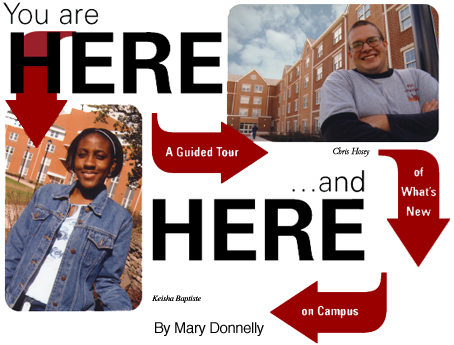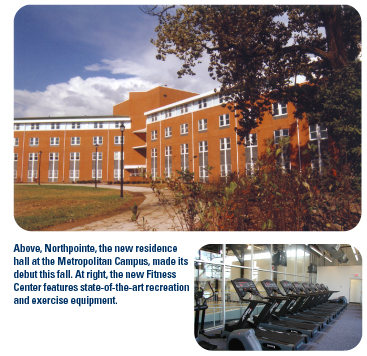

So you haven’t been on campus lately? Newly constructed buildings and other significant renovations both on the Metropolitan Campus and at the College at Florham have changed the face of the University, while providing attractive and comfortable venues for enjoying collegiate life.
FDU Magazine recently received a fresh perspective on all that’s new through a walking tour of the campuses, courtesy of Keisha Baptiste, a sophomore civil engineering technology major on the Metropolitan Campus, and Chris Hosey, a senior psychology major at the College at Florham. The two veteran tour guides are experts at steering anxiety-ridden prospective students and their parents through the campuses.
“When possible, I try to customize the tours to meet the needs of the families,” Baptiste explains, the lilting cadence of her native Trinidad singing through her words. She laughingly recalls one prospective engineering student whom she helpfully introduced to engineering professor and director of the school of Computer Sciences and Engineering Alfredo Tan during the course of the tour. Tan’s enthusiasm runneth over, however. “He took over my whole tour and talked to the student for the next hour. Luckily, there was only one family on that tour.”
Both Hosey and Baptiste are well versed in their campus offerings, describing to parents and high school seniors what majors are available, the extracurricular options and the best places to eat. Both also are very familiar with the campus security measures in place (easily the most common question from parents). And both share a trade secret of every good tour guide: When in doubt, refer the question to the appropriate department or administrator. “I am quite honest when I don’t know the answer to a question,” Baptiste explains. “I usually refer them to the Web site or the department.”
A River View
Baptiste starts her tours from Dickinson Hall on the Hackensack side of the Metropolitan Campus. After checking out the 5,000-seat George and Phyllis Rothman Center, where Division I athletes compete, she guides eager visitors along the Hackensack River and across the foot bridge. As they cross to the Teaneck side of campus, a major addition comes into view: Northpointe, a 300-bed residence hall. The 85,000-square foot, four-story, chevron-shaped structure blends into the campus skyline as if it were always there.

The building opened in October, and Baptiste was among the
lucky inaugural year residents. “This is the first year I am a campus RA
[resident assistant] and I get to do it in the very newest of dorms,” she
exclaims enthusiastical-
ly. Each spacious two-person room has two beds, one
bathroom and microwave/refrigerator capability. Additionally, each floor has a
lounge, a vending machine area and a laundry room.

Baptiste then hits all the landmarks on the Teaneck side of the campus from Jeepers, where students can grab a quick bite, to the new Metropolitan Club, a lounge for faculty and staff, both in Alumni Hall, to the Student Union Building, the ultimate destination for students active on campus and the home of the Rutherford Room, with memorabilia devoted to the University’s founding site.
The current star of the Metropolitan Campus tour, though, says Baptiste, is the new Fitness Center. “Most of the people on the tour love the Fitness Center!” Who wouldn’t? Opened in January, the new center is located where the “Old Gym” was. The original brick facade of the old building has been retained, and walls of glass brighten the interior.
A magnet for students and faculty — “You can work out with your professors,” Baptiste excitedly declares — the facility offers a large central court for pick-up basketball and volleyball games. Free-weight and selectorized weight rooms bracket a large space dedicated to cardiovascular exercise equipment. And, directly across the basketball court from the lobby, a wall of mirrors fronts an aerobics and dance studio.
Ideally located for the large commuter student population, and occupying one entire end of the Fitness Center is a spacious, wood-paneled student lounge, complete with computer ports and a large-screen television. The lounge was the scene of one of Baptiste’s more embarrassing moments, when, leading a tour through the building, she inadvertently tripped the fire alarm when opening a fire-exit door. “I was completely mortified,” Baptiste shamefacedly explains. “Luckily, the tour was small, and the receptionists turned the alarm off right away.”
Additionally, the Metropolitan Campus also boasts other new features, such as a recently constructed softball field with dugouts and outdoor lighting near the Edward Williams Building in Hackensack. Also just completed is the renovation of the area occupied by the Peter Sammartino School of Education in Bancroft Hall. And, the campus has invested heavily in upgrading the existing residence halls, and extensive improvements have been made to Robison Hall. In addition, more green spaces were added with the elimination of several old structures and construction of a new pedestrian thoroughfare.
Steeped in History
As befitting a tour guide for a campus that once was a luxurious estate, Chris Hosey is well versed in history. Starting from the Mansion, designed in the 1890s by Stanford White, he points out, “It was used as the setting for the Governor’s Ball in the movie, ‘A Beautiful Mind.’” He adds that viewers, thinking the setting was Princeton University, were in fact watching a scene played out in the Mansion and its picturesque gardens.

As Hosey and his groups walk from the Mansion down the tree-lined pathways, he explains that the park-like setting of the campus is no accident. “Frederick Law Olmsted, the landscape architect for Central Park, planted two of every tree native to the East Coast on the grounds.”
During his tour, Hosey takes visitors to one of the prime new attractions on campus, the recently renovated Student Center. A major hub for all students, the center was expanded by 14,000 square feet, and the building facade was dramatically changed to closely echo the Georgian design of the other campus buildings. The dining hall was enlarged and a coffee house with a “Friends”-like feel provides atmosphere and an often-needed caffeine rush.
The center also now offers spacious facilities for student activities and organizations. The renovation saw improved meeting spaces and club offices for student organizations. President of the Student Leadership Association (SLA), a community service club, Hosey says, “It’s now much easier to access a conference room for our meetings.”

“I try to be a positive role model,” Hosey explains, adding that he plans on a career in teaching. Hosey wants to teach second grade because, he feels, “it’s where children experience critical development.”
And FDU has provided him with the tools to excel as a teacher. “The professors are great and are always there for you,” he says. “The classes are small and eventually you get to know almost everyone.” The intimacy of the campus is vividly on display during the tour as Hosey is “high-fived” and greeted by at least 20 different students.
Hosey’s tour continues with in-depth looks at major buildings such as the Roberta Chiaviello Ferguson and Thomas G. Ferguson Recreation Center (which includes a Rutherford Room dedicated to the original campus); the Martin F. Stadler, Patrick J. Zenner, Hoffmann-La Roche Inc. Academic Building; and the Park Avenue Residence Hall — all constructed in the last decade.
Hosey also has brand new buildings to show off. The College at Florham welcomed a new residence hall this fall. Rutherford Hall is located across the courtyard from the Twombly Residence Halls and, like the renovated Student Center, its red-brick exterior complements the Georgian-style design of the other campus buildings. The L-shaped, 85,000-square-foot, four-story building provides 300 beds with two-students per room and bathroom facilities for every room.
Another significant addition to the College at Florham is the 6,000-square-foot facility known as Chaîne House, which was built to house the headquarters of Confrérie de la Chaîne des Rôtisseurs, the world’s premier gourmet society, and the University’s International School of Hospitality and Tourism Management. The building stands near the library where the old career center was located.
Another new project that Hosey can point to with pride is the renovation of the campus’s Robert T. Shields Athletics Field, which now includes artificial turf, aluminum bleachers, a grandstand and a press box.
A Common Theme
While the campuses differ in their appearance and feel, and although the Metropolitan Campus emphasizes professional and international studies and the College at Florham is grounded in the liberal arts, the two share common elements that characterize Fairleigh Dickinson University. It starts with the University-wide mission to provide a global education and continues through the level of commitment displayed by faculty, staff and students on both campuses — people like Baptiste and Hosey, who laud their respective professors and describe feelings of inclusiveness that permeate the campuses.
“It’s so easy and fun to get involved in campus life,” says Hosey. Baptiste agrees, “There is something for everyone on the campus. As an international student, I found an open-armed welcome for me wherever I turned for help.”
FDU Magazine Home | Table of Contents | FDU Home | Alumni Home | Comments